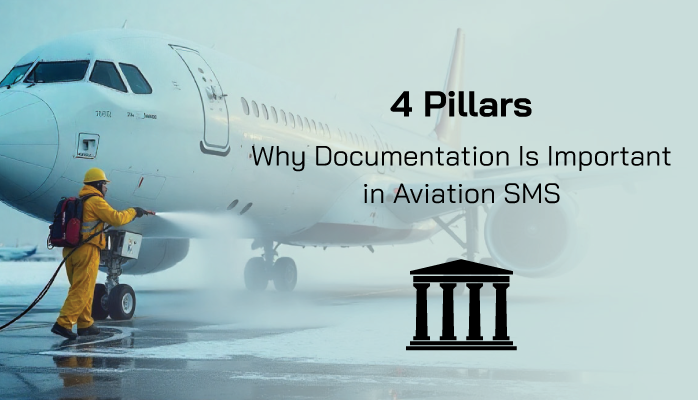What Is Documentation in Aviation SMS?

In November 2006, the International Civil Aviation Authority (ICAO) mandated that all member states implement formal aviation safety management systems (SMS). Each member state's civil aviation authority (CAA) is responsible for providing oversight to ensure the operators required to implement the aviation SMS comply.
Aviation SMS implementations need to be accounted for in 2 main ways. First, they need to be functioning, which means that SMS components are actively used by employees in the company. Second, the SMS' risk management activities need to be "documented."
Related Aviation SMS Documentation Articles
- Best Practices for Documenting Your Aviation SMS
- How to Document Your System Processes in Aviation SMS
- 5 Times Documentation Saves Safety Managers in Aviation SMS
In essence, what documentation “means” for an aviation SMS implementation is that:
- The SMS' risk management activities can be “read” and easily reviewed;
- The SMS' risk management processes are justified in writing;
- Goals, current existence, and plans for improvement are “written down” for future review processes;
- The various parts and systems of the SMS are described in sufficient detail to facilitate both effective safety risk management (SRM) activities and routine auditing by both internal and external auditors;
- Employees and authorized stakeholders can consistently and efficiently carry out management's recipe for success;
- Records are kept as proof of all of the above points.
What Are Goals of Aviation SMS Documentation?

The goal of documentation in aviation SMS is to:
- ensure compliance;
- provide a framework for repeated business processes to be performed safely and efficiently;
- save time and money training employees; and
- demonstrate that your aviation SMS is professionally managed and doesn't require heightened levels of regulatory oversight.
Compliance in aviation SMS programs is indicated when:
- Documentation describes the aviation SMS and the interaction of its various parts;
- Documentation is reviewed and updated on a regular basis; and
- Documentation is readily available to all relevant employees.
SMS documentation is usually consolidated into:
- an SMS manual;
- data management tools, such as spreadsheets and paper;
- software point solutions that may address defined areas of the SMS, such as safety reporting system, risk management system, and auditing system; or
- full-featured aviation SMS database that stores all SMS documentation in a centralized data management strategy.
Related Aviation SMS Database Articles
- 5 Most Important Things to Know Before Buying Aviation SMS Database
- How to Choose Aviation SMS Software - Educating SMS Professionals
- 7 Signs You Need an Aviation Safety Management (SMS) Database
How Does Documentation Relate to Aviation SMS' 4 Pillars?
Documentation is the key component and backbone of the aviation Safety Policy component of the 4 pillars of aviation SMS implementations. The other 4 components of the Safety Policy fall under the umbrella of documentation:
- Safety accountability;
- Management commitment and responsibility;
- Appointment of key safety personnel; and
- Coordination response planning.
Appointment of key safety personnel mostly falls under the umbrella of functional SMS but the rationale should be documented. The only difference between SMS documentation and Safety Policy is that Safety Policy includes the need for safety personnel to act in order to create policy.
“Documentation” simply covers the actual documentation and not necessarily the effort to create it. This is an important point to remember because it means when we talk about documentation, we are only talking about the physical (or digital) records.
Documentation Components in Aviation SMS

Documentation in aviation SMS implementations covers the following areas:
- Records management;
- Regulatory requirements for the SMS;
- The scope, integration, and framework of the SMS;
- Safety policies and procedures;
- Safety goals and objectives;
- Accountability of roles in the safety program;
- The type and scope of the hazard reporting system;
- Historical aviation safety training;
- Management of change;
- SMS auditing preparation and results;
- Safety communication methods;
- Safety performance indicators;
- Leading indicators of performance and lagging indicators of performance; and
- Hazard identification and risk assessment processes.
All of the above items are critical to the framework of compliant aviation SMS.
The act of documenting them necessarily entails that these items are functional in the system. If all of these items are present and updated, it demonstrates to SMS auditors a highly functioning SMS implementation. This is an important point.
SMS auditors need demonstrable and objective proof that SMS requirements are satisfied. Demonstrable and objective evidence is perhaps the area that most operators suffer from when they undergo their routine SMS audits. According to the SMS auditors, "If it isn't documented, it never happened."
Related Aviation SMS Auditing Articles
- Audit Checklist: 10 Things to Prepare for Aviation SMS Audits
- Real Difference Between an Aviation Safety Audit vs. Inspection
- How to Conduct Internal SMS Audits in Aviation Industry
Relationship Between Records Management and Documentation
Records management is a particularly important area of SMS documentation. When SMS implementations have great documentation but poor records management it indicates:
- That the aviation SMS is a "false front," and only exists on paper (i.e., there is no record's management because there is nothing to record!); or
- A poor safety culture that lags considerably behind the compliance efforts of safety management teams.
Records management should be similar in complexity and scope to other documentation efforts. Records management is exactly what it sounds like records of safety activities in your company. Record management are things like:
- Hazard identification and risk analysis;
- Safety issue reporting;
- Safety issues' risk management activities, investigations, and subsequent validation;
- Records of SMS training attendance and end-of-course-assessments;
- Safety performance monitoring and non-performance tracking and escalation processes;
- Safety performance metrics, such as leading indicators, KPIs, safety goals and objectives, and risk analysis charts;
- Internal and external audit findings;
- Safety meetings;
- Emergency response plan drills ;
- Management of change activities; and
- Safety promotion activities, such as safety newsletters, safety surveys, and safety posters.
All of the above items are perfect candidates for records management because they are “proof” that the SMS implementation is real and functioning.
Final Thought: 5 Most Important Risk Management Tools for Documentation
Tools for documentation are usually:
- Spreadsheets;
- Aviation safety databases, either commercial or created in-house;
- Aviation safety software;
- A local server that stores all documents, such as SharePoint or retrofitted help-desk ticketing software; and/or
- A physical location for documentation.
An aviation safety database, software, or server is best as it provides the readiest access for all employees. The most important risk management tools that you need for documentation are:
- Safety policies and procedures management;
- Hazard identification and risk analysis;
- Safety reporting and risk management systems;
- Risk analysis charts;
- Safety goals and objectives; and
- Safety performance monitoring.
All of the above points provide a great combination of compliance documentation, proof of functional SMS, and records management.
Employee performance monitoring is absolutely critical for building a safety culture, understanding safety performance, and giving employees accountabilities for their safety behavior. Here are some resources that will prove immensely helpful to get you started:
Last updated in August 2025.








